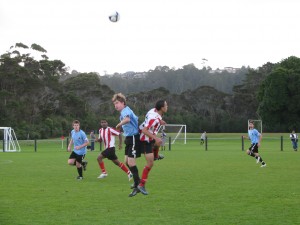A cross to the far post will always be a great way to score a goal. However, the aggressive skill of jumping and heading under pressure takes courage and is a complex movement for kids 10 and under. Children of this age are fearful of headers and think they could become injured. Your job as a coach is to introduce all aspects of the game to your players and help them through their fears. Here are some ways to help conquer the fear of the header and how to head the ball the right way. 
1. Begin teaching headers by suspending (with a string or rope) a somewhat deflated ball from a cross¬bar so that their forehead can make contact with it when standing. Only use a fully inflated ball when your players have gained some confidence.
2. Contact with the ball should be made square on so that the forehead can strike it. Keep the eyes on the ball at all times. In fact, have your players cultivate the habit of ‘throwing the eyes’ at the ball.
3. To transfer power to the ball a player must also get power from the body. This is best done by swaying the upper part of the trunk backwards and forwards from the hips with one foot in front of the other.
4. Once confidence has been gained about striking the ball the next step is to concentrate on timing. As the ball is swinging, the body movement must coincide with the head making contact. Have players try to punch the ball with their head, using their body to gain extra power.
5. Now increase the height of the suspended ball by about eight inches. Players will now have to jump to make contact, and must jump early enough to get their body in a position to add the power. They should jump from both feet, arching their back slightly then thrust forward from the hips at the right time with the body and head. Have the players throw the eyes at the ball and head it with a jack-knife action. As they thrust forward they should notice that their feet moves forward as well. There are two movements here, one of jumping as high as they can and the other in the heading movements. The two must be performed together.
6. Now put the ball a few inches higher still and have players take a few paces back. With a couple of strides they are to take off from one foot, and head the ball power¬fully downwards.
It is best to start all heading practice sessions on the suspended ball before going out on to the practice field for more serious work. A heading practice session needs good service in the form of either chipping or throwing. An excellent game to start with is a game across half a field which is played like basket¬ball in which the ball is played alternately with the head and hands. A goal can only be scored by heading the ball in.
The ideal final pass to the far past is to a point just outside the corner of the goal area, just out of the goalkeeper’s reach. Enough space should be left in front so that the player can move forward at the right time, jump high and head at the goal. The best place to put the header is back across the goal, because the keeper will move across to cover the near post.
Tell your players to go hard for the ball, try to win it, and they’ll get far more goals than headaches. Before long even the most fearful pee wee player will be heading with ease.


this is s**t, doesn’t help conquer any fear in those real game situation, should find a better way to get rid of the fear, jumping at a ball is not the same as colliding with a ball booted by the goalie